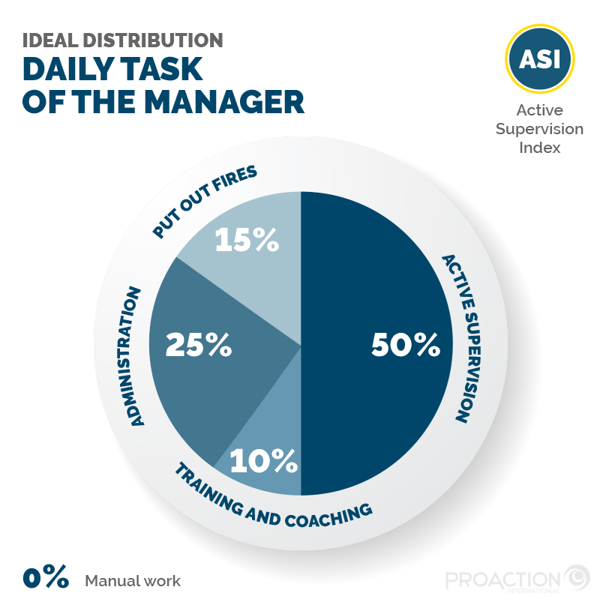The different types of key performance indicators
Organizations can use a wide range of key performance indicators (KPIs), including operational, financial, and knowledge indicators, to evaluate their performance and level up to their optimal potential.
However, measuring managerial competency might not be as straightforward as measuring churns or profits, for instance. That’s why we have developed a measurement technique that uses key behavioral indicators (KBIs).
Effective managers understand their role and responsibilities, and are better able to take ownership of best management practices and implement them within their teams. Their skill set includes great operational rigor, problem-solving capabilities, a coaching management style, and great communication skills. KBIs measure such managerial behaviors that contribute to organizations' performance and growth.
But before jumping into key behavioral indicators and how to use them to measure management skills, let’s examine the role of the manager as a creator of value for their team and organization, as well as common tools to evaluate manager performance.
The importance of defining the value of managers
Calculating an employee’s added value is usually straightforward. You compare the time spent working on “billable” activities to an attainable expected standard of speed and quality, thus obtaining an added value rate.
However, calculating the added value of managers is much more complex.
In their new management position, the employee moves from creating direct value through technical skills to creating indirect value through other people's skills (and value). This is probably the most extreme transformation in one’s career.
Managers add value by moving their team’s performance from its current state to the potential state, reducing the gaps in-between.
When managers understand their own value for the organization, the impact on their team can be exponential.
Tools and processes to evaluate managerial skills
Employee performance evaluations, or performance reviews, are a human resources management activity that assesses individual goal achievement. They are also used for raises in salary and internal promotions.
Managers, too, should be subject to these evaluations as it is also important to assess key management skills and build action plans for them to adopt the best managerial behaviors. This ensures that leaders have the competencies required to drive team performance.
Tools to assess key management skills typically include questionnaires, peer reviews, and one-on-one meetings.
However, few companies integrate performance review processes into their human resources management system. A consulting firm specializing in management skill and behavior analysis can help:
- Structure the approach.
- Gather information.
- Analyze the results.
- Recommend appropriate action plans and support their implementation.
How to measure managerial knowledge
Managers’ knowledge of their leadership role and responsibilities is often overlooked when promotions are given in an organization. Yet it is a key indicator of a manager’s decision-making ability and the quality of the leadership they provide to their team.
Management Skills Index
Here are 5 management skills you need to observe when assessing managers' knowledge of their roles and responsibilities:
- Planning skills
- Interpersonal skills (communication)
- Execution skills
- Supervision skills
- Continuous improvement skills
By assessing the level of knowledge and understanding of more than 16,000 managers, Proaction International has come to the following conclusion:

Proaction International has a team dedicated to actively monitoring management best practices, and over 15 years of experience in developing executives’ skills across North America and Europe, all industries combined (heavy industry, distribution, logistics, tertiary, construction, etc.).
On average, 38% of frontline managers have very low knowledge and understanding of management best practices. 24% have a weak grasp of it.
Only 7% of frontline managers, in all industries, say they have an excellent understanding of their management role and responsibilities.
However, this does not mean that 2 out of 3 managers do not belong in their position or have no potential. They simply need to develop their leadership skill set.
The point is that frontline managers are – most of the time – excellent field employees. For example, many companies promote their best assembly line operator or sales department representative, without training and coaching them on their managerial role and behavior.
As a result, these managers might not feel confident in their position and able to guide their team, which can lead to decreased productivity and engagement, lack of communication and trust, and costly production errors.
Measuring managerial knowledge can reveal gaps – sometimes significant – between management levels and even between members of the same supervisory team.
But the data shown above and the individual progress made at customers’ sites help us develop, implement, and adjust training and coaching plans to improve management skills for the long term.
Measuring managerial knowledge to encourage positive transformation
The data from the Management Skills Index only illustrate an initial state. Monitoring how the results evolve over time will help identify gaps in management skills and guide decision-making.
Implementing efficient training and coaching strategies allows for significant improvements in management skills. It also helps uncover high-potential managers who may not stand out.
Knowledge of management best practices is critical to management skills. However, a successful manager requires more. That’s why managers' know-how or quality of management should also be measured.
How to measure quality of management
Another key behavioral indicator is know-how on the field, i.e., the quality of daily management of frontline teams.
This management skill can be assessed from two angles:
- The amount of active supervision.
- Management effectiveness.
Active Supervision Index
Managers have to pack many tasks and priorities into limited time. They are often required to do manual work to help their staff, on top of time-consuming administrative tasks, email management, meetings, team planning, etc.
Calculating the Active Supervision Index involves recording all activities performed in a typical day and classifying them into 5 categories:
- Active supervision
- Training and coaching
- Administrative tasks
- Manual work
- Passive supervision
Calculating the percentage of time allocated to each category provides the proportion of time actually spent on active supervision.

Proaction International found that managers generally spend most of their day on administrative tasks, regular meetings, and emergency management. This reduces the time they can devote to value-added activities such as:
- Fostering team engagement.
- Planning and coordinating activities (active supervision).
- Developing individual skills (training and coaching).
If managers spend 30 minutes a day on active supervision, they don’t have time to go beyond basic management to invest in continuous improvement.
So measuring the quality of the manager's interventions on the field will clarify the value they create for their team and organization.
Management Effectiveness Index or Management Maturity
We have said before that the role of the manager is to capture performance gaps to guide their team in reaching its full potential.
There are all kinds of performance gaps: human, methodological, technical, organizational, etc. So we need to measure the management behaviors that enable managers to capture those gaps and create efficiency gains to improve performance.
At Proaction International, years of analysis and coaching of managers from various industries allowed us to identify 5 main managerial maturity stages. The Management Effectiveness Index assesses the level of managerial maturity which helps define the appropriate skill development plan:
- Task assignment
- Task management
- Measuring performance
- Resolving variances
- Proactive management

Level 1: Task assignment
Perhaps the first management skill a new manager learns is to assign tasks to their team to ensure everyone knows what to do. This can sound simple, but not all managers can master it without proper training and coaching (think of some roadworks sites…).
Level 2: Task management
Once managers have mastered task assignment, they need to ensure customer expectations are met. A good managerial reflex is to believe that: “We exist because of our customers, so I’ll make sure we deliver what they need on time and that they are satisfied.”
At this level, managers ensure all team members are in the right place at the right time and deliver the expected product or service on schedule, thus achieving great performance results.
Level 3: Measuring performance
Here, managers feel responsible for improving performance and ensuring the organization benefits from delivering customer value. They understand the performance criteria or objectives that make up for a “good day,” communicate them to their team, and follow up on them.
Level 4: Resolving variances
With a clear definition of what “performance” means, managers can move on to capturing discrepancies hindering operations' full potential and causing performance losses. They seek to identify what prevents teams from generating better results by capturing these variances in method, flow, velocity, etc., and find ways to rectify the situation.
This is where a manager truly starts to create added value and drive performance improvement to help the company achieve better results.
Level 5: Proactive management
The fifth and final stage that managers can reach in their career is proactive management. Not only do they notice recurring variances over time, but they strive to achieve long-term resolution by eliminating the root cause.
At this point, they have become a managerial leader. This is the leadership style of high-performing managers who fully understand their role and responsibilities, drive team engagement, and generate organizational performance day after day.
The Management Effectiveness Index is the ultimate behavioral indicator as it focuses on improving business performance.
Improving performance involves capturing the gaps between potential and reality. Managers bring reality closer to the ideal by reducing non-value-added activities in the organization.
As the managerial effectiveness or maturity improves – from task assignment to proactive management – so does the organization's performance. This transformation can lead to tremendous gains not only financially, but also on human and strategic levels.
Here are some of the benefits related to better management skills:
- Labor cost savings
- Improved health and safety
- Better material yield
- Increased team engagement
Improving key management skills to drive performance
Using key behavioral indicators (KBIs) such as the Management Skills Index, the Management Effectiveness Index, and the Active Supervision Index allows for a more tangible assessment of leadership skills.
This is the first step towards better business performance and growth. Improving management competencies such as planning skills, interpersonal skills, problem-solving skills, and communication skills has a huge, positive impact on all areas of the business. It increases productivity as well as engagement, health and safety, and the quality of products and services.










